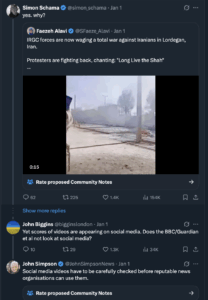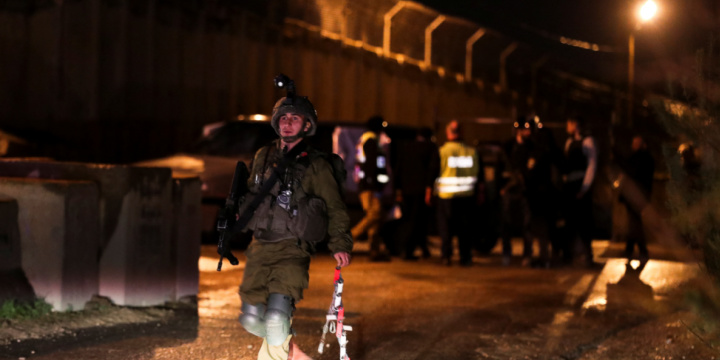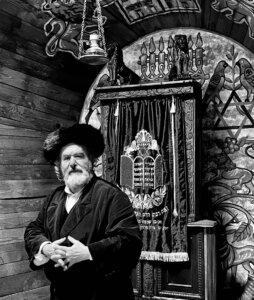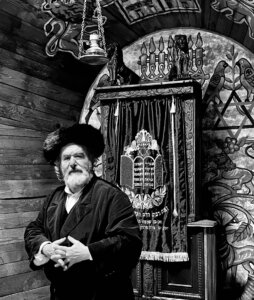Uncategorized
A rabbi went down with his torpedoed warship in 1943. Today, his cousin ensures his story is not forgotten.
(JTA) — Mark Auerbach was not yet 5 years old when he noticed an unusual stamp in his father’s dresser. The well-worn three-cent stamp featured a drawing of a small group of men and a sinking ship, with the words “The Immortal Chaplains… Interfaith in action.” It piqued his interest, so he asked his father about it.
“Our cousin is on that,” Auerbach, who grew up in Brooklyn, recalls him saying, searching for an age-appropriate explanation. “He said he was a rabbi who died during World War II when his boat was torpedoed by the Germans. He made me promise to make sure that the story is never forgotten.”
It’s a promise that Auerbach, 75, who now lives in Passaic, New Jersey, has taken to heart. He’s made it his life’s mission to keep alive the story of the “Four Chaplains” — who included Auerbach’s third cousin, Rabbi Alexander D. Goode, along with Rev. George Fox, Rev. Clark Poling and Father John Washington. Eighty years ago today, they made the ultimate sacrifice when their ship, U.S.A.T. Dorchester, was torpedoed and sunk by a German submarine in the North Atlantic in the pre-dawn hours.
Over the decades, Auerbach has amassed a trove of photos, clippings and memorabilia dedicated to the bravery and faith of these four clergymen — including preserving countless copies of that three-cent stamp, which was issued in May 1948. “It’s an amazing story,” said Auerbach of the chaplains’ heroism. “It just happens to be my family.”
The sinking of the Dorchester is considered one of the country’s worst World War II-era sea disasters: Of the 902 men on board, only 203 survived. As survivors and historians attest, the four clergy — all relatively new soldiers who had befriended one another at the Army Chaplains School at Harvard University — stood out for their calming presence throughout the pandemonium that occurred during the 18 minutes it took for the ship to go under. As the tragedy rapidly unfolded, survivors reported that the chaplains offered prayers, helped distribute lifejackets and, once those ran out, they selflessly gave up their own.
The three-cent stamp dedicated to the Four Chaplains was issued in 1948 and sparked Auerbach’s interest in the story. (Courtesy Mark Auerbach)
“The altruistic action of the four chaplains constitutes one of the purest spiritual and ethical acts a person can make,” reads materials from Four Chaplains Memorial Foundation, whose mission is “to promote Interfaith Cooperation and Selfless Service,” according to their web site. “When giving their life jackets, Rabbi Goode did not call out for a Jew; Father Washington did not call out for a Catholic; nor did the Reverends Fox and Poling call out for a Protestant. They simply gave their life jackets to the next man in line.”
But that’s not all they did. As the ship went down, survivors have said that they saw the four chaplains on deck, linked arm in arm together in prayer. “I could hear men crying, pleading, praying,” Private William B. Bednar, who was floating among the bodies of his shipmates in the freezing water, is quoted as saying in foundation reports. “I could also hear the chaplains preaching courage. Their voices were the only thing that kept me going.”
The four men became friends at chaplains school at Harvard. (Courtesy Mark Auerbach)
According to Rabbi Dov Peretz Elkins, the author of “Rabbi Alexander Goode: The Story of the Rabbi and His Three Fellow Chaplains Who Went Down with the USAT Dorchester” in November 2022, the clergy were heard saying their respective prayers as the ship sank: Goode said the Shema; the Catholic priest the Ave Maria, while the two ministers said the Lord’s Prayer. (Exactly how survivors might have heard this is unclear, though Elkins confirmed that the Shema is the last thing a Jew is supposed to say before death.)
Goode was born in Brooklyn in 1911; his father, Hyman Goodekowitz, was also a rabbi. When his parents divorced, he moved to Washington, D.C. with his mother and siblings. Goode was a good student and excellent athlete, and “believed that it was God’s plan for him to pursue a religious calling,” Elkins said.
Goode graduated from the University of Cincinnati in 1934 and Hebrew Union College in 1937; in 1940, he got a PhD from Johns Hopkins University. “Education was very important to him,” said Auerbach. In 1935, he married Teresa Flax, who happened to be a niece of Al Jolson; the couple had a daughter, Rosalie, in 1939.
As a rabbi, his first assignment was at a synagogue in Marion, Indiana in 1936; in 1937, he transferred to Beth Israel in York, Pennsylvania, where he remained until he enlisted in July 1942. “He excelled in ecumenicalism — his congregation really praised him and loved him specifically for that,” Elkins said. “He had a wonderful reputation as a scholar, a beloved rabbi and ecumenical person.”
As Elkins writes in his book: “In his new community, Alex made great efforts to spread interfaith understanding. He presented a regular radio program on religious matters. When one of the local churches burned down, he offered to host the congregation’s religious services.”
“He was an extraordinary person, [in addition to] what he did on the Dorchester,” Elkins added.
According to an account from a Dorchester survivor, Petty Officer John J. Mahoney, courtesy the Four Chaplains Foundation, Goode acted selflessly at least one more time that awful morning: He thwarted Mahoney from a foolhardy attempt to return to his cabin for his gloves. Instead, Goode gave Mahoney his gloves, assuring him he had two pairs.
In retrospect, “Mahoney realized that Rabbi Goode was not conveniently carrying two pairs of gloves, and that the rabbi had decided not to leave the Dorchester.”
For a time in the postwar era, the story of the chaplains’ bravery was a popular one, including among children. (Courtesy Mark Auerbach)
During the postwar era, for a while, at least, the story of the Four Chaplains was a popular one. In addition to laudatory articles and the commemorative stamp — plus assorted memorabilia designed to draw the attention of children — memorials were constructed “in nearly every state,” according to Elkins; stained-glass tributes can be found at the Pentagon, the National Cathedral and elsewhere. In Philadelphia, President Harry Truman dedicated a memorial chapel to the Four Chaplains on Feb. 4, 1951. According to a JTA report at the time, some 10,000 “Americans of all faiths” raised $300,000 for the chapel’s construction and furnishings; at the ceremony, Goode’s father read Psalm 96 in Hebrew.
On Dec. 19, 1944, each of the chaplains was posthumously awarded the Purple Heart and the Distinguished Service Cross. In 1998, the 55th anniversary of the Dorchester disaster, Feb. 3 was deemed Four Chaplains Day by Congress. And yet, as World War II fades into distant memory, few people today seem to be familiar with the heroism of these men.
“It’s such an important story, such an inspiring story, it needs to be better known,” said Elkins on the impetus for his book.
“This guy certainly was a great role model,” Elkins said of Goode in particular. “We need more Alexander Goode type of people for our youth to look up to, to say, ‘I can be honest, intellectual, committed to my faith and my people, the heritage of Judaism, and I can do honorable things.’”
On Sunday, as he does every year on the Sunday closest to Feb. 3, Auerbach and other chaplains’ family members will attend a memorial mass at St. Stephen’s Roman Catholic Church in Kearny, New Jersey, where he’ll also display his collection of photographs and memorabilia. “The story is so ecumenical that it crosses all kinds of barriers,” he said. “It’s the ‘Golden Rule’ in reality. Every clergy person worth their salt — whatever day their religious observance is, whether its Saturday or Sunday — every one of them is preaching be kind to your brother, your sister. Everyone talks about it, few know about it. This is something for people to grab onto.”
Elkins concurs. “These guys are role models for all of us,” he said. “It doesn’t mean you have to give up your life. There are all kinds of ways people can do great things.”
—
The post A rabbi went down with his torpedoed warship in 1943. Today, his cousin ensures his story is not forgotten. appeared first on Jewish Telegraphic Agency.
Uncategorized
The Iranian People Are Demanding Their Freedom; Where Is the Media?

Protesters demonstrate against poor economic conditions in Tehran, Iran, with some shopkeepers closing their stores on Dec. 29, 2025, in response to ongoing hardships and fluctuations in the national currency. Photo: ZUMA Press Wire via Reuters Connect
“What were the media doing when the regime led by Ali Khamenei finally fell?”
That is the question that will be asked if, as many Iranians now dare to hope, we are witnessing the final days of the Islamic Republic after more than four decades in power. It is also a question the Western press may struggle to answer.
How It Started
The current wave of unrest began in late December, when shopkeepers in Tehran went on strike amid growing fury over Iran’s collapsing economy. The rial hit record lows, while prices continued to soar under crippling inflation. Traders, wholesalers, and merchants took to the streets in protest, initially over economic mismanagement — but anger quickly turned toward the regime itself.
Within 48 hours, demonstrations had spread beyond the capital to major cities including Isfahan, Shiraz, Mashhad, Hamadan, Qeshm, and beyond. Videos posted by Iranians showed crowds chanting explicitly political slogans: “Death to the dictator,” “Mullahs must go,” and “This homeland will not be free until the mullah is gone.”
Iranian state-affiliated media have acknowledged several deaths. Independent estimates suggest the toll may be significantly higher. What is not in dispute is that the unrest has rapidly evolved from economic protest into a broad-based challenge to clerical rule.
The Story the Media Barely Told
And yet, on Friday, The New York Times ran not a single front-page story on the protests.
Not one.
This was unrest that — if it succeeds — could reshape Iran, the Middle East, and global security dynamics for decades. A regime that backs Hamas and Hezbollah, arms terrorist proxies across the region, threatens Israel’s destruction, and destabilizes international energy markets was facing its most sustained nationwide dissent in years. Still, the story barely registered.
The New York Times’ near silence was not an outlier. It was emblematic.
When the lack of coverage was challenged on social media, John Simpson, World Affairs Editor at the BBC, offered an almost comical defense: social media videos, he said, must be carefully verified before “reputable outlets” can use them.

That principle, in isolation, is uncontroversial. But its selective application is not.
This is the same BBC that has repeatedly broadcast unverified — or lightly verified — footage and photographs from Gaza. In Iran, however, verification suddenly became an insurmountable obstacle, even as dozens of videos from multiple cities showed consistent scenes, slogans, and patterns of unrest.
When Framing Does the Regime’s Work
Reports by the BBC and analyses from BBC Verify have repeatedly emphasized “cost-of-living protests,” despite verified footage of crowds chanting for the end of clerical rule and attacking regime symbols.
Where BBC Verify has undertaken the “verification” John Simpson said was so difficult, it has drawn criticism for focusing on debunking isolated instances of AI-generated imagery — rather than acknowledging the overwhelming volume of genuine footage documenting brutality against protesters.
Genuinely shocked to see BBC Verify have chosen now to be out there giving an impression we should not believe what we are seeing in #Iran based on one image (of a real event).
Amplification of this intensely organic revolution by Israeli social media accounts is making many…
— Omid Djalili (@omid9) January 2, 2026
Sky News, Reuters, FRANCE24, and others followed a similar pattern — leading with rising prices and economic stagnation while giving little attention to the unmistakably political slogans echoing through Iranian streets.
This framing matters. Protests about inflation suggest reform. Protests calling for the removal of the Supreme Leader suggest regime collapse.
In some cases, Western coverage has gone further, adopting the regime’s preferred framing outright.
When President Donald Trump warned that the United States would respond if Iranian protesters were massacred, Iranian officials condemned the remarks as “reckless.” Several outlets, including the BBC, led with that condemnation, centering Tehran’s outrage and implicitly casting the United States, rather than the Islamic Republic, as the destabilizing force.
Last week, The Guardian even published an opinion piece by Iran’s foreign minister, Abbas Araghchi, under the headline: “You’ll never defeat us in Iran, President Trump: but with real talks, we can both win.”

Put simply, this was The Guardian lending its pages to the propaganda of a senior official from the very regime Iranians are risking their lives to oppose — the same Islamic Republic that beat Mahsa Amini to death for allegedly wearing her hijab incorrectly, executed protesters, imprisoned dissidents, and ruled through fear for 45 years.
1/
Western media coverage of Iran’s escalating nationwide protests has been strikingly limited and cautious – despite widespread anti-regime demands across dozens of cities.Why the reluctance, when evidence is abundant?
pic.twitter.com/PWF9hgsdI3
— HonestReporting (@HonestReporting) January 3, 2026
So Why Is the Media Reporting This Way?
Western journalists do not lack information about Iran. The evidence is abundant and often supplied at immense personal risk by Iranians themselves.
What appears lacking is not access, but editorial willingness.
Acknowledging an evolving anti-regime uprising would force uncomfortable conclusions: that long-standing assumptions about “stability,” “reform,” and diplomatic engagement with Tehran were misplaced; that the Islamic Republic is not merely flawed but fundamentally illegitimate; and that Western governments and institutions have spent decades accommodating a brutal regime now being openly rejected by its own people.
It is easier — safer — to frame unrest as economic grievance, to hide behind verification rhetoric, or to platform regime voices as “context.”
But if this uprising succeeds, history will not be kind to that caution. And the question will remain: When Iranians were demanding freedom, why did so much of the Western media look away?
The author is a contributor to HonestReporting, a Jerusalem-based media watchdog with a focus on antisemitism and anti-Israel bias — where a version of this article first appeared.
Uncategorized
Palestinian Authority Police Commit Another Terrorist Attack

Illustrative: Israeli forces gather at the scene of a shooting attack near a Jewish outpost, near Nablus, in the West Bank, December 16, 2021. REUTERS/Ammar Awad
When Palestinian Authority (PA) police officer and Fatah’s Al-Aqsa Martyrs’ Brigades terror-wing member Younes Walid Shtayyeh shot at Israeli special forces and wounded an Israeli soldier near Nablus, it was not cause for self-scrutiny on behalf of the PA police.
On the contrary, two days later, PA Police Commissioner Allam Al-Saqqa elaborated on the “professional police establishment, which acts as a law enforcement body.” He stressed that the PA police force “maintains security, public order, and morality,” a message the official PA TV reporter summarized by claiming the PA police are “loyal … to the law:”
PA Police Commissioner Allam Al-Saqqa: “[Our progress] emphasizes the integrative relationship between the State Prosecutor’s Office and the [PA] Police, through participation in enforcing justice in the criminal field, which is being protected by a skilled State Prosecutor’s Office that is striving to strengthen the rule of law, alongside a professional police establishment, which acts as a law enforcement body, operates in coordination with the State Prosecutor’s Office and under its supervision, maintains security, public order and morality, and fulfills its role within the framework of the law” … [emphasis added]
[Official PA TV News, Nov. 22, 2025]
According to PA ideology, there really is no contradiction between trying to murder Israelis and maintaining the law. Fatah and Hamas alike glorified the “operation” of police terrorist Shtayyeh, and after he was killed by Israeli forces, social media overflowed with praise for him.
Palestinian Media Watch has documented the double role of the PA police and Security Forces as cops by day — and terrorists by night — many times, recently in the report, Terrorists in Uniform.
Fatah’s terror wing announced with “pride and glory” that Shtayyeh’s funeral was a “wedding” and stressed that the PA police officer died while “fulfilling the duty of struggle and engaging in armed confrontation with enemy.”
The Al-Aqsa Martyrs’ Brigades also used the opportunity to pledge to continue “the path of struggle” until “the removal” of the State of Israel:
Posted text: “A military statement by the Al-Aqsa Martyrs’ Brigades
…
Martyr fighter Younes Walid Shtayyeh — one of the fighters of the Al-Aqsa [Martyrs’] Brigades — Nablus
Who ascended to Heaven as a Martyr on Friday, Nov. 21, 2025 … while he was fulfilling the duty of struggle and engaging in armed confrontation with enemy …
The Al-Aqsa Martyrs’ Brigades, while accompanying the Martyr commander to the wedding, pledge before Allah that their fighters will continue … on the path of struggle and resistance, until the removal of the occupation from our land and our occupied holy sites.This is a revolution until victory!
The Al-Aqsa Martyrs’ Brigades – Palestine
The military wing of the Fatah Movement
Saturday… Nov. 22, 2025″ [emphasis added][Al-Aqsa Martyrs’ Brigades, Telegram channel, Nov. 22, 2025]
Fatah political officials paid condolence visits to the family, while Fatah’s terror wing described the police terrorist as a “heroic Martyr”:
Posted text: “Fatah Movement Nablus District Secretary Muhammad Hamdan ‘Abu Al-Mutaz’ and members of the district committee in a visit of blessing and condolences on the ascent to Heaven of heroic Martyr Younes Walid Shtayyeh.” [emphasis added]

The terrorist’s father praised his death as a “Martyr,” saying it was “anticipated” and that Allah “chose him”:
Father of terrorist Younes Walid Shtayyeh: “Younes… there is no one who doesn’t love him… May Allah have mercy on him [and] be pleased with him … He asked for [Martyrdom] and achieved it.
We anticipated this … We consider him a Martyr with Allah. .. The [Israeli] army’s special forces besieged the area … He took his weapon and went out, he fought them outside and fell as a Martyr … All this is the decree of Almighty Allah. Our Lord chose him [to be a Martyr].” [emphasis added]
[“Nablus News,” Telegram channel, Nov. 22, 2025]
A Hamas-affiliated network honored the terrorist, sharing a video of him posing with and firing an assault rifle, while a song played in the background:
Song lyrics: “Do not mourn, for eternal life awaits us
Shed no tears, for Paradise is the appointed meeting place
I sacrifice myself to meet Allah, for the sake of life [in Paradise] and [Allah’s] satisfaction”Posted text: “Images of [PA] police officer Martyr Younes Shtayyeh, the one who carried out the shooting operation on the occupation soldiers while they were making arrests in Nablus a few days ago. [An operation] in which he ascended to Heaven while confronting an Israeli Yamam force.” [emphasis added]
[Quds News Network (Hamas), Telegram channel, Nov. 22, 2025]
The “Al-Quds Brigades – Grandchildren of Glory,” Islamic Jihad’s terror wing, posted pictures of the terrorist, pointing out he was a police officer:

Posted text: “[PA] police officer Martyr Younes Walid Shtayyeh, whom the occupation (i.e., Israel) accuses of shooting at its forces during the raid on Nablus yesterday”
[“Al-Quds Brigades – Grandchildren of Glory,” Telegram channel, Nov. 21, 2025]
Other groups applauded terrorist Shtayyeh as a “Jihad fighter” and stressed that he was “a son of the Fatah Movement. A son of the Palestinian Security Forces”:

The author is a contributor to Palestinian Media Watch, where a version of this story first appeared.
Uncategorized
An idyllic Jewish village, full of life and hope, just hours before its utter annihilation

A remarkable scene in Ady Walter’s film Shttl takes place in a Jewish Ukrainian village outside of Kiev on June 21, 1941, one day before the Nazi invasion, known as Operation Barbarossa.
The Rebbe, played by the always excellent Saul Rubinek is the voice of reason; he is a thoughtful, complex, contradictory and conflicted character. He does not raise his voice, he takes time to consider what to say as he himself struggles to respond to whatever factionalism arises within the community. His sad eyes are expressive. He repeatedly rubs his thumb across his fingers. This is a master class in consummate acting.
The mostly black-and-white Yiddish language film, currently playing in New York at New Plaza Cinemas, spans 24 hours in the shtetl, whose residents remain clueless of the impending doom despite the presence of the Russian Army that has already infiltrated the village. Nonetheless the cracks are surfacing within the community. Intense arguments abound on such issues as workers rights and whether to abandon religion or commit to a devoted life. One female character espousing the need for women’s rights, anticipates the future struggle of feminism in the face of patriarchy.
At its core, the film explores Jewish identity, unity and survival. The Rebbe understands factionalism yet remains implacable as he urges the townspeople to be Talmudic in their judgments, tolerant and compassionate. He describes true Jewishness as the color gray, allowing for and even respecting differences of opinion, purpose and worldview.

For, the Rebbe, Jews must always remain unified on some profound level. “Unity is the only thing that matters in the battle against evil,” he asserts. His second tenet is faith in God. Doubt can never enter the picture.
The central character, Mendele (Moshe Lobel in a nicely understated performance) is an aspiring filmmaker, who has long since left the shtetl to join the Red Army in Kyiv. But he returns home along with his best friend, a non-Jewish Ukrainian named Demyan (Petro Ninovskyi), so he can elope with his true love, Yuna (Anisia Stasevich), the child of The Rebbe.
But Yuna is already engaged through an arranged marriage to Folie (Antoine Millet), a cruel, autocratic Hasid who, despite his alleged religiosity, is petty, sly, cunning and ultimately violent.
Mendele remains torn between his ambitions embodied by the cosmopolitan outside world and the restrictive, confined shtetl where he is still deeply rooted. And he can’t help but feel connected to his estranged father, whom he holds responsible for the suicide of his late mother who, like Mendele, was also an outlier.
The film was shot in Ukraine in 2021 at the height of COVID-19 restrictions and at the very moment the Russian invasion was looming. The set, including a synagogue, was supposed to be converted into a museum honoring Ukraine’s Jewish past. But in the end, the Russian forces destroyed the whole shtetl set and the land was mined. Now that the president of Ukraine is a Jew at the very same time antisemitism is surging across the globe and Ukrainians and Jews are both under assault, the parallels and irony are almost implausible.
Walter, a documentary film director making his feature debut, has said his mission was to bring the shtetl universe that was totally wiped out during the Holocaust back to life. The title Shttl with its missing “e” references the 1969 novel, La Disparition by Georges Perec, whose mother died in Auschwitz. In Perec’s fictional work the letter “e” never appears in Shttl, its absence mirroring the emptiness, the void, the loss.
In this film, unlike such Holocaust classics like Schindler’s List, The Pianist, Son of Saul, death, despair, and hopelessness are not yet part of the collective experience. This is life prior to the Holocaust in an ethnically diverse community overflowing with purpose and hope for the future. Many Jews and gentiles enjoy camaraderie, and Yiddish and Ukrainian are both spoken.
Shtll’s cinematic technique is evocative, specifically the way scenes of recollection seamlessly morph into color — Mendele recalls his life as a yeshiva boy and the time his gentle mother gave him a baby rabbit as a pet. The colorful flashbacks suggest the past is so much more vivid than the black-and-white present.
Nevertheless, I found the film problematic. Though it has been praised for its one-shot cinematic approach, which purports to make the movie more immediate, real and immersive for the viewer, the set and the inconsistent performances made it feel more like a filmed stage play to me. And, more importantly, the characters don’t seem like actual human beings as they do spokespersons for various political, philosophical,and religious viewpoints. The quirky folkloric figures don’t help. There are two holy fools of various stripes — a beatific deceased mom who appears as a spectral figure, and my favorite, the butcher who has become a vegetarian.
Admittedly, my image of shtetl life is informed by a Fiddler on the Roof ethos and, by extension, the stories of Sholem Aleichem which presents a largely impoverished, insular and marginalized world, even if its residents don’t see themselves as disenfranchised. But in Shtll, the youthful characters are self-confident in their speech, gestures, and especially their wide-stride, swaggering gaits. They seemed jarringly secular and contemporary to me.
In one scene, our three protagonists, including Yuna, are happily passing back and forth a bottle of booze, each guzzling from the communal cap. The provincial virginal daughter of The Rebbe in a 1941 shtetl? Really?
In the end, though, the film makes a 180-degree turn that nearly eradicates its flaws. Mendele, Demyan, and Yuna have spent the night in the forest and have fallen asleep content in their certainty that at sunrise they will be embarking on their great adventure to freedom.
As dawn breaks and the sun begins to emerge over the trees. Mendele hears gunfire and spies the battalions of Nazis entering the shtetl en masse. The obliteration that will follow is clear. The respective politics, philosophies, not to mention petty jealousies, indeed, all the internecine fighting on the one hand and the moments of jubilation on the other have become totally meaningless. The realization is devastating.
The post An idyllic Jewish village, full of life and hope, just hours before its utter annihilation appeared first on The Forward.





